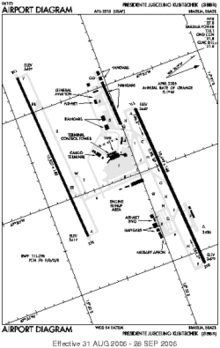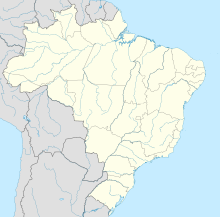Brasília International Airport
Brasília–Presidente Juscelino Kubitschek International Airport Aeroporto Internacional de Brasília–Presidente Juscelino Kubitschek | |||||||||||||||
|---|---|---|---|---|---|---|---|---|---|---|---|---|---|---|---|
 | |||||||||||||||
| Summary | |||||||||||||||
| Airport type | Public/Military | ||||||||||||||
| Operator | Infraero, Inframérica | ||||||||||||||
| Serves | Brasília | ||||||||||||||
| Hub for | |||||||||||||||
| Elevation AMSL | 1,066 m / 349 ft | ||||||||||||||
| Website | Infraero BSB | ||||||||||||||
| Map | |||||||||||||||
| Runways | |||||||||||||||
| |||||||||||||||
| Statistics (2011) | |||||||||||||||
| |||||||||||||||


Brasília–Presidente Juscelino Kubitschek International Airport (IATA: BSB, ICAO: SBBR) is the airport serving Brasília, Brazil. Since April 22, 1999 the airport is named after Juscelino Kubitschek de Oliveira (1902–1976), the 21st President of Brazil.[4]
In 2011 the airport was ranked 3rd in terms of transported passengers and aircraft operations, and 6th in terms of cargo handled in Brazil, placing it amongst the busiest airports in the country.[5]
Some of its facilities are shared with the Brasília Air Force Base of the Brazilian Air Force.
History
Brasília was only a project when in 1956 President Juscelino Kubitschek landed for the first time in the Central Plateau. However, Vera Cruz Airport, built in 1955 by the then Deputy-Governor of Goiás, Bernardo Sayão, at the request of the chairman of the location of the New Federal Capital, Marechal José Pessoa, already existed. On October 2, 1955, the airport received the first crew of workers that would build the new capital. This facility was located where today is the Integrated Bus and Train Terminal of Brasília. It had a dirt runway of 2,700 meters and a passenger terminal in a makeshift shack cob wall covered with buriti-leaves.[6]
This facility, however, was only temporary. The relocation to a definitive site had already been identified as a priority and construction works started on November 6, 1956. The works lasted for only over six months and required the clearing of an area of 1,334 million square meters, 178,500 square meters of earthwork, base-stabilized 40,900 m², covering 73,500 m², topographical services, positioning and leveling. The runway was designed to have a length of 3,300m but initially it had only 2,400m, and was 45m wide. The passenger terminal was built on wood. On April 2, 1957, the presidential aircraft landed for the first time at the site and the official inauguration took place on May 3, 1957. That year, on the same location the Brasília Air Force Base was also commissioned.[6]
In 1965 Oscar Niemeyer made a project to Brasília Airport to replace the wooden terminal. However, due to the 1964 Brazilian coup d'état, the military-government chose to build the project of Tércio Fontana Pacheco, an architect of the Brazilian Air Force Ministry. The airport is thus one of the few important buildings in Brasília that is not related to Niemeyer.[7] This building was opened in 1971 and since 1990 it is under renovation following an architectural concept of the architect Sergio Roberto Parada.
In 1990 Brasília International Airport underwent its first major renovation and began to gain its present form with a central body and two satellites. The first phase included the construction of an access-viaduct to the passenger terminal and metal cover inaugurated in 1992 and the first circular satellite, inaugurated in 1994. In the second phase, the main body of the passenger terminal was renovated to include a shopping-mall and the satellite received nine jetways. In 2005, a second runway was opened. Presently, the second satellite is under construction.[6]
Because in its design, the present terminal is capable of handling 9 million passengers per year and actually handling 14 million with numbers constantly increasing, the former terminal for general aviation, originally built in 1988, was renovated and transformed into Passenger Terminal 2. It was opened for traffic on August 2, 2010.[8]
Following a decision made on April 26, 2011 by the Federal Government for private companies being granted concessions to explore some Infraero airports,[9] on February 6, 2012, the administration of the airport was conceded, for 25 years, to the Consortium Inframérica, formed by the Brazilian Engineering Group Engevix (50%) and the Argentinean Group Corporación América (50%).[10] Inframérica also won the concession of São Gonçalo do Amarante – Natal International Airport in Brazil on May 12, 2011.[11] Infraero, the state-run organization, will remain with 49% of the shares of the company incorporated for the administration.[12][13]
The Brazilian Integrated Air Traffic Control and Air Defense Center section 1 (Cindacta I) is located in the vicinity of the airport.[14]
Terminals, airlines and destinations
| Airlines | Destinations | Terminal |
|---|---|---|
| American Airlines | Miami | 1 |
| Avianca Brazil | Aracaju, Belo Horizonte-Confins, Cuiabá, Florianópolis, Fortaleza, Ilhéus, João Pessoa, Juazeiro do Norte, Porto Alegre, Porto Velho, Recife, Rio de Janeiro-Santos Dumont, Salvador da Bahia, São Paulo-Congonhas, São Paulo-Guarulhos | 1 |
| Azul Brazilian Airlines | Belo Horizonte-Confins, Campinas-Viracopos, Foz do Iguaçu, Porto Alegre | 2 |
| Copa Airlines | Panama City | 1 |
| Delta Air Lines | Atlanta | 1 |
| Gol Airlines | Aracaju, Belém-Val de Cães, Belo Horizonte-Confins, Boa Vista, Campinas-Viracopos, Campo Grande, Cruzeiro do Sul, Cuiabá, Curitiba-Afonso Pena, Fortaleza, Goiânia, João Pessoa, Juazeiro do Norte, Macapá, Maceió, Manaus, Marabá, Natal, Palmas, Porto Alegre, Porto Velho, Recife, Rio Branco, Rio de Janeiro-Galeão, Rio de Janeiro-Santos Dumont, Rosário, Salvador da Bahia, São Luís, São Paulo-Congonhas, São Paulo-Guarulhos, Teresina, Uberlândia, Vitória Charter: Aruba, Curaçao | 1 |
| Passaredo Linhas Aéreas | Alta Floresta, Barreiras, Belém-Val de Cães, Carajás, Londrina, Porto Alegre, Ribeirão Preto, Salvador da Bahia, Santarém, São José do Rio Preto, Sinop | 1 |
| PLUNA | Montevideo | 1 |
| SETE Linhas Aéreas | Goiânia, Gurupi, Minaçu, São Félix do Araguaia | 2 |
| TACA Airlines operated by Lacsa | Bogotá, San José de Costa Rica [begins June 2][citation needed] | 1 |
| TACA Perú | Lima [ends June 1, 2012] | 1 |
| TAM Airlines | Aracaju, Belém-Val de Cães, Belo Horizonte-Confins, Boa Vista, Campinas-Viracopos, Campo Grande, Cuiabá, Curitiba-Afonso Pena, Florianópolis, Fortaleza, Foz do Iguaçu, Goiânia, Imperatriz, João Pessoa, Macapá, Maceió, Manaus, Marabá, Miami, Natal, Palmas, Porto Alegre, Porto Velho, Recife, Rio Branco, Rio de Janeiro-Galeão, Rio de Janeiro-Santos Dumont, Salvador da Bahia, São José do Rio Preto, São Luís, São Paulo-Congonhas, São Paulo-Guarulhos, Teresina, Vitória | 1 |
| TAM Airlines operated by Pantanal Linhas Aéreas | São Paulo-Congonhas | 1 |
| TAP Portugal | Lisbon | 1 |
| TRIP Linhas Aéreas | Araguaína, Manaus, Uberaba, Uberlândia, Vitória | 1 |
| Webjet | Curitiba-Afonso Pena, Goiânia, Porto Alegre, Porto Seguro, Ribeirão Preto, Rio de Janeiro-Santos Dumont, Salvador da Bahia, São Paulo-Guarulhos | 1 |
Accidents and incidents
Accidents with fatalities
- 22 December 1962: a Varig Convair CV-240-2 registration PP-VCQ flying from Belo Horizonte-Pampulha to Brasília descended below the prescribed altitude while on final approach to Brasília, struck trees, skidded and fell to one side. One crew member died.[15]
- 25 May 1982: a VASP Boeing 737-2A1 registration PP-SMY on landing procedures at Brasília during rain, made a hard landing with nose gear first. The gear collapsed and the aircraft skidded off the runway breaking in two. Two passengers out of 118 occupants died.[16]
- 29 September 2006: Gol Airlines flight 1907, a Boeing 737-8EH registration PR-GTD en route from Manaus to Brasília collided with a business jet Embraer Legacy on its first leg, fell, disintegrated in midair, and crashed into the Amazon forest in the north of the State of Mato Grosso, killing all of the 154 passengers and crew on board of the Gol aircraft.[17]
Incidents
- 25 April 1970: a VASP Boeing 737-2A1 en route from Brasília to Manaus-Ponta Pelada was hijacked by a person who demanded to be flown to Cuba. The hijack lasted a day.[18]
- 14 May 1970: a VASP Boeing 737-2A1 en route from Brasília to Manaus-Ponta Pelada was hijacked by a person who demanded to be flown to Cuba. The hijack lasted a day.[19]
- 22 February 1975: a VASP Boeing 737-2A1 registration PP-SMU en route from Goiânia to Brasília was hijacked by a person who demanded ramson. The hijacker was taken down.[20]
Access
The airport is located 11 km (7 mi) from downtown Brasília.
Future developments
On 31 August 2009, Infraero unveiled a BRL514.8 million (USD306.06 million; EUR224.76 million) investment plan[21] to up-grade Pres. Juscelino Kubitscheck International Airport focusing on the preparations for the 2014 FIFA World Cup and the Summer Olympics in 2016 which will be held in Brazil, Brasília being one of the venue cities:
- Enlargement of apron and taxiways. Value 34.5. Completion: April 2011
- Renovation of the existing passenger terminal. Value 22.5. Completion: November 2011
- Enlargement of the passenger terminal. Value 439.0. Completion: April 2013
- Parking. Value 18.8. Completion: April 2014
See also
References
- ^ "Infraero Statistics for the Airport" (PDF) (in Portuguese). Infraero.
- ^ "Airport Official Website" (in Portuguese). Infraero.
- ^ "Lista de aeródromos públicos" (in Portuguese). ANAC.
- ^ "Lei n˚9.794, de 20 de abril de 1999" (in Portuguese). Lei Direto. April 22, 1999. Retrieved May 25, 2011.
- ^ "Estatísticas" (in Portuguese). Infraero. Retrieved February 20, 2012.
- ^ a b c "Aeroportos: Brasília" (in Portuguese). Jetsite. Retrieved May 31, 2011.
- ^ Parada, Sergio Roberto. "Aeroporto de Brasília, uma questão de arquitetura" (PDF) (in Portuguese). IABDF. Retrieved May 25, 2011.
- ^ "Terminal 2 do aeroporto de Brasília recebe voos regulares" (in Portuguese). Infraero. September 1, 2010. Retrieved September 30, 2010.
- ^ Bitencourt, Rafael (April 26, 2011). "Governo define concessão de obras em 3 aeroportos, diz Palocci" (in Portuguese). Valor Online. Retrieved May 16, 2011.
- ^ Rittner, Daniel (February 7, 2012). "Cumbica, Viracopos e Brasília são privatizados" (in Portuguese). Valor Econômico. Retrieved March 22, 2012.
- ^ Guimarães, Ligia (August 22, 2011). "Consórcio Inframérica vence leilão de aeroporto São Gonçalo do Amarante" (in Portuguese). G1. Retrieved March 22, 2012.
- ^ Salomon, Marta; Monteiro, Tânia (June 1, 2011). "Governo pretende privatizar três aeroportos e abrir o capital da Infraero" (in Portuguese). O Estado de São Paulo: Economia. Retrieved March 22, 2012.
- ^ "Brazil moves swiftly (at last) to award airport concessions". CAPA. February 9, 2012. Retrieved March 5, 2012.
- ^ "Cindacta I" (in Portuguese). Brazilian Air Force: Departamento de Controle do Espaço Aéreo DECEA. Retrieved May 4, 2011.
- ^ "Accident description PP-VCQ". Aviation Safety Network. Retrieved 16 May 2011.
- ^ "Accident description PP-SMY". Aviation Safety Network. Retrieved 30 May 2011.
- ^ "Accident description N600XL and PR-GTD". Aviation Safety Network. Retrieved 13 May 2011.
- ^ "Incident description Vasp April 25, 1970". Aviation Safety Network. Retrieved 30 May 2011.
- ^ "Incident description Vasp May 14, 1970". Aviation Safety Network. Retrieved 30 May 2011.
- ^ "Incident description PP-SMU". Aviation Safety Network. Retrieved 30 May 2011.
- ^ Rittner, Daniel; Braga, Paulo Victor (August 31, 2009). "Infraero vai gastar R$5 bi em reforma de aeroportos". Valor Econômico (in Portuguese). pp. A4. Retrieved March 22, 2012.
External links
- Template:WAD
- Airport information for SBBR at Great Circle Mapper. Source: DAFIF (effective October 2006).
- Current weather for SBBR at NOAA/NWS
- Accident history for BSB at Aviation Safety Network
- Brasília International Airport Photo Archive at airliners.net
- Documentary about Brasília International Airport

